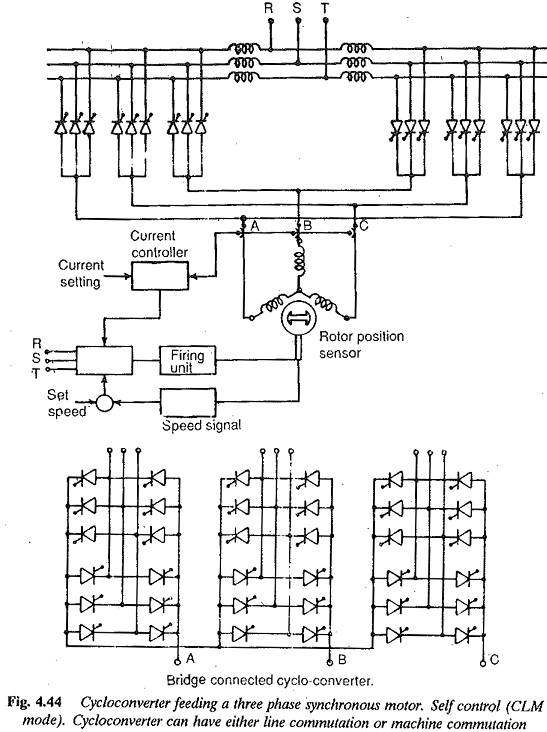Three Phase Synchronous Motor Fed From Cycloconverter:
DC link converter is a two stage conversion device which provides a variable voltage, variable frequency supply. Variable voltage, variable frequency supply can be obtained from a cycloconverter which is a single stage conversion equipment. The power circuit of a Three Phase Synchronous Motor Fed From Cycloconverter is shown in Fig. 4.44. This has several differences compared to a dc link converter.
The line voltages are made use of to commutate the thyristors of a cycloconverter. The output frequency can be varied from 0 — 1/3 of the input frequency. The range of speed control is therefore limited, extending from 0 — 1/3 base speed. Cycloconverters are inherently capable of power transfer in both directions. Four quadrant operation is simple.
A cycloconverter in the above speed range gives a high quality sinusoidal output voltage. The resulting currents are also nearly sinusoidal. The harmonic content of the current is small. Consequent effects of harmonic current, such as losses, heating and torque pulsations are minimal. The line power factor is somewhat better because the machine power factor can be made unity.
A Synchronous Motor Fed From Cycloconverter requires a large number of thyristors and its control circuitry is complex. Converter grade thyristors are sufficient but the cost of the converter is high. The efficiency is good and the drive has a good dynamic behaviour. The operation in CLM mode is popular.
A Synchronous Motor Fed From Cycloconverter drive is attractive for low speed operation and is frequently employed in large, low speed reversing mills requiring rapid acceleration and deceleration. Typical applications are large gearless drives, e.g., drives for reversing mills, mine hoists, etc.
A cycloconverter can also be commutated using the load voltages if the load is capable of providing the necessary reactive power for the inverter. An overexcited synchronous motor can provide the necessary reactive power. Hence a cycloconverter feeding such a motor can be load commutated. The range of speed control is from medium to base speed. At very low speeds load commutation is not possible. The speed range can be extended to zero if line commutation is used at low speeds. Four quadrant operation is simple. The problems associated with harmonics are minimal due to high quality of the output. The line power factor depends on the angle of firing and is poor. The cost of the converter is high with complex control. Its efficiency is good and the drive has a fast response. It finds application in high power pump and blower type drives.
